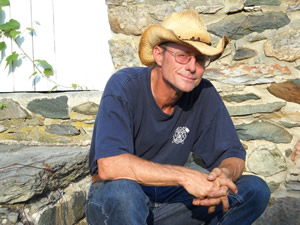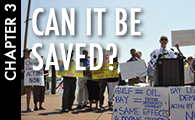Chapter 3: Can the Bay Be Saved — And How?

(photo by Jason Lenhart - News21)
Government agencies may need a different strategy this time if they hope to rid the Chesapeake of its toxins.
The last campaign, a collective effort in which the EPA joined forces with Maryland, Virginia, New York, Pennsylvania, Delaware and the District of Columbia, has been widely regarded as a failure. Since the first bay agreement was signed in 1983, scientists say that at best, the cleanup campaign has slowed the rate of pollution, not reversed it-- despite billions of dollars spent on sewer-plant upgrades and the passage of many pollution-fighting measures.
In June this year, a group of scientists, environmental advocates and former elected officials held a joint press conference on the Annapolis city dock to lobby for more effective action by lawmakers.
“Despite commitments in 2000 to do so, the states have failed by a wide margin to meet the 2010 deadline for pollution reduction goals necessary to restore the Bay,” says the letter the group signed and presented to bay-area governors and the mayor of Washington. “This means that most of the Bay’s waters fail to meet basic Clean Water Act requirements.”
According to the Chesapeake Bay Foundation, by 2009, Virginia had achieved only 13 percent of its 2011 goal of fencing cattle out of streams; Maryland had achieved only 19 percent of a reduced 2011 goal of using cover crops to help filter nitrogen and phosphorous; and Pennsylvania had reached just 5 percent of its 2011 goal of increasing farm acreage under nutrient management plans.
Experts say meeting the new goals won’t be any easier. There has been considerable blowback from stakeholders about the federal government stepping in and telling states what to do, and politicians so far have been unwilling to ram through legislation that would be unpopular with their constituents, particularly farmers and developers.
 Cows at a Pennsylvania farm.
Cows at a Pennsylvania farm.(photo by Sharon Behn - News21)
Controlling farm runoff is perhaps the thorniest challenge—and the area where the least amount of regulation has occurred. States are under-resourced and subject to fierce lobbying from agri-business interests, especially the poultry industry. Poultry giants Perdue, Tyson, Mountaire and dairy giant Land O’ Lakes have large interests across the watershed.
“None of the states want the feds to come in and take over or get involved in maintaining compliance,” says Russell Brinsfield, executive director of the Harry B. Hughes Center for Agro-ecology in Queenstown, Md. “There is pushback from the stakeholders.”
“I think in general it is the lack of political backbone from our politicians to create the regulations or agencies to enforce the regulations on the books,” Brinsfield says.
Last winter, EPA officials sent signals it planned to crack down on animal manure, long laxly regulated in bay states. Now for the first time, many large chicken farms are required to obtain pollution control permits from state governments, after first filing “nutrient management plans” explaining how they will minimize nutrient runoff.
But there are so many chicken and livestock farms in Maryland and Pennsylvania that the requirements have created a backlog of permit applications and bogged down the agencies administering the permits.
While some farmers agree they need to do more to clean up their farms, they also feel they are being unfairly targeted, and point to the growing storm-water and wastewater runoff pollution.
“Uh, where’s the equality there? We need to replace some of these antiquated sewage systems,” says Al Wanner, a large dairy farmer in south central Pennsylvania who supplies the Land O’ Lakes cooperative and has invested heavily in manure recycling.
 James Dunlap
James Dunlap(Photo by Sharon Behn - News21)
James Dunlap, owner of a small, 11-acre organic crop farm in Virginia, says that without commercial farming, people across the world would starve. “We’ve backed ourselves into a corner,” he says.
“I can’t conceive of any easy way out of the situation we’re in,” Dunlap adds. “Population rises, consumption of resources rises, the supply of resources dwindles, pollution destroys the food chain slowly but surely. It’s a train wreck, you know, and it’s going to happen.”
In Congress, Cardin has been fighting for an upgrade to the Clean Water Act that provides funding and imposes deadlines for Chesapeake Bay watershed states to set pollution restrictions. Although his $2 billion-plus bill passed the Senate Environment and Public Works Committee with a bipartisan vote, some of its more stringent language was removed first, after lobbying from the farm lobby and other stakeholders worried about granting the EPA too much authority. While the House has yet to take up the companion bill, in July the House Agricultural Committee approved a competing bill sponsored by two Virginia Republicans and endorsed by agricultural interests.
Cardin does not consider the 27-year-old clean-up campaign a total failure, noting that without the state’s efforts to deal with development, agricultural practices and wastewater treatment, “the quality of the bay today would be much worse.”
But he concedes that government has not met expectations. “We should have done better,” he says. “The bay is in trouble, and it requires more aggressive action.”
Government officials say more public support will be needed for the spending that will be required to clean up the bay. Part of the problem is that many people just don’t know about the level of pollution, or appreciate the wonders of the Chesapeake. Public access to the bay has become increasingly limited, with large sections of the shoreline owned by wealthy landowners, hotels and restaurants.
For the 26.8 million people living in Maryland, Pennsylvania, Virginia and the District, there are 761 public access points to the bay and rivers leading to its waters. According to the Chesapeake Bay Program, Pennsylvania and D.C. have no public swimming beaches, Virginia has 47 and Maryland has 44 along the bay and its tributaries. That’s roughly 90 bay-related beaches for the almost 13 million residents of those two states.
The EPA plan calls for expanded public access, by adding at least 300 new places where people will be able to enjoy the Chesapeake and its tributaries.
Weary of waiting for change, environmental advocates like Phillips, the Assateague riverkeeper, have started filing legal actions using the federal Clean Water Act to push for compliance.
Legislation is all about compromise, she says. “That’s why I’m a waterkeeper; I don’t want to compromise,” she says. “If there’s pollution happening, I want it to stop.”
- Login to post comments





